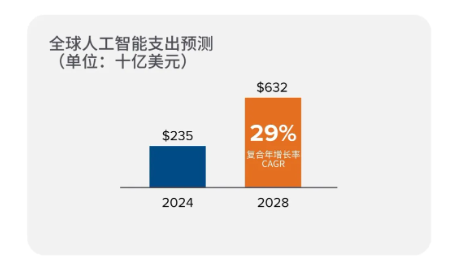IDC's latest report predicts that global artificial intelligence spending will increase to $632 billion by 2028, doubling the current level. The rapid development of generative artificial intelligence (Gen AI) is the main driving force. Its five-year compound growth rate is as high as 59.2%, bringing huge investment opportunities to enterprises. Software spending will dominate, followed closely by hardware and IT services spending. There are also differences in the degree of application and investment scale of AI in different industries. Financial services, software and information services, and retail will be the main contributors, while the business and personal services fields will have the fastest growth rate. The editor of Downcodes will explain the key contents of this report in detail.
Recently, the International Data Corporation (IDC) released its latest global artificial intelligence and generative artificial intelligence spending guide, predicting that global spending on artificial intelligence (AI) will double to $632 billion by 2028. The main driving force for this growth is that generative artificial intelligence technology (Gen AI) is gradually being integrated into more products, which not only makes people look forward to it, but also brings new investment opportunities to enterprises.

According to IDC's forecast, the global artificial intelligence market will grow at a compound annual growth rate of 29% from 2024 to 2028. This means that enterprises’ investment in AI technology, applications and related services will increase significantly. Investment in generative artificial intelligence is particularly prominent, with a five-year compound growth rate of 59.2%.
While current spending on generative AI remains lower than other types of AI applications, such as machine learning and natural language processing, investment in this area will grow rapidly over time, with spending expected to reach $2 billion by 2028. billion, accounting for 32% of total expenditures.
In terms of spending categories, AI software will be the largest spending area, expected to account for more than half of the total market. Two-thirds of all software spending will be on AI-enabled applications and platforms, with the remainder going toward developing and deploying AI applications. In terms of hardware, including servers and storage, spending will become the second largest category. The growth rate of IT and business services cannot be underestimated, with a compound annual growth rate of 24.3%.
There are also significant differences in AI application spending among various industries. IDC predicts that in the next five years, the financial services industry will lead the way, contributing more than 20% of AI spending, followed by software and information services and retail. It is worth mentioning that AI spending in business and personal services is growing the fastest, with an average annual growth rate of 32.8%.
AI infrastructure configuration will be the main application scenario, but its growth rate is relatively low, with a compound annual growth rate of 14.7% expected. The application scenarios with the fastest growing spending include enhanced claims processing and digital commerce, with average annual growth rates of 35.8% and 33.2% respectively. Among the 42 AI application scenarios covered by IDC, 30 will have an average annual growth rate of more than 30%.
Highlight:
- Global AI spending is expected to double to $632 billion by 2028.
- ? The five-year compound growth rate of generative artificial intelligence is as high as 59.2%, making it an investment highlight.
- ? The financial services industry will contribute more than 20% of AI spending in the next five years.
All in all, artificial intelligence, especially generative artificial intelligence, is developing at an unprecedented speed, injecting new vitality into the global economy. IDC's predictions provide an important reference for enterprises to invest in the field of artificial intelligence, and also indicate that artificial intelligence technology will be more deeply integrated into all walks of life in the future. The editor of Downcodes recommends that enterprises pay attention to the latest developments in generative artificial intelligence and seize development opportunities.